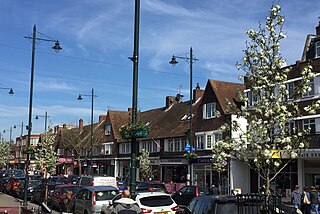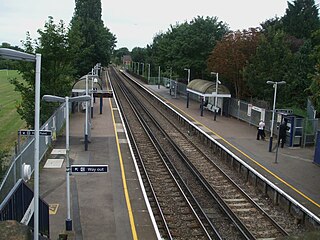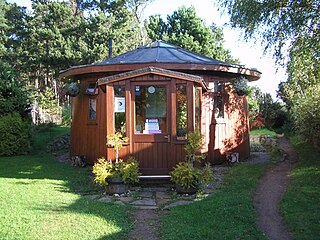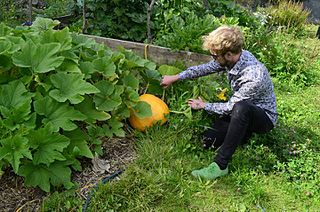Related Research Articles

Squatting is the action of occupying an abandoned or unoccupied area of land or a building, usually residential, that the squatter does not own, rent or otherwise have lawful permission to use. The United Nations estimated in 2003 that there were one billion slum residents and squatters globally. Squatting occurs worldwide and tends to occur when people who are poor and homeless find empty buildings or land to occupy for housing. It has a long history, broken down by country below.

An ecovillage is a traditional or intentional community with the goal of becoming more socially, culturally, economically, and/or ecologically sustainable. An ecovillage strives to produce the least possible negative impact on the natural environment through intentional physical design and resident behavior choices. It is consciously designed through locally owned, participatory processes to regenerate and restore its social and natural environments. Most range from a population of 50 to 250 individuals, although some are smaller, and traditional ecovillages are often much larger. Larger ecovillages often exist as networks of smaller sub-communities. Some ecovillages have grown through like-minded individuals, families, or other small groups—who are not members, at least at the outset—settling on the ecovillage's periphery and participating de facto in the community.

Hounslow is a large suburban district of West London, 10.7 miles (17.2 km) west-southwest of Charing Cross. It is the administrative centre of the London Borough of Hounslow, and is identified in the London Plan as one of the 12 metropolitan centres in Greater London.

Brentford is a suburban town in West London, England and part of the London Borough of Hounslow. It lies at the confluence of the River Brent and the Thames, 8 miles (13 km) west of Charing Cross.

Chiswick is a district of west London, England. It contains Hogarth's House, the former residence of the 18th-century English artist William Hogarth; Chiswick House, a neo-Palladian villa regarded as one of the finest in England; and Fuller's Brewery, London's largest and oldest brewery. In a meander of the River Thames used for competitive and recreational rowing, with several rowing clubs on the river bank, the finishing post for the Boat Race is just downstream of Chiswick Bridge.

The London Borough of Hounslow is a London borough in West London, England, forming part of Outer London. It was created in 1965 when three smaller Middlesex council areas amalgamated under the London Government Act 1963. It is governed by Hounslow London Borough Council.

Isleworth is a town located within the London Borough of Hounslow in West London, England. It lies immediately east of the town of Hounslow and west of the River Thames and its tributary the River Crane. Isleworth's original area of settlement, alongside the Thames, is known as 'Old Isleworth'. The north-west corner of the town, bordering on Osterley to the north and Lampton to the west, is known as 'Spring Grove'.

St Margarets is a suburb and neighbourhood in the London Borough of Richmond upon Thames, about 9 miles (14 km) west-southwest of central London. It is bounded by the Thames Tideway to the north-east, and the River Crane to the north-west and north where the land tapers between these rivers. Land and buildings closer to Richmond Bridge than the eponymous railway station are, traditionally distinctly, known as East Twickenham. Both places go by their post town and traditional parish, Twickenham quite often; in the 19th century the south of St Margarets was marked on maps as Twickenham Park.

Whitton is an area in the London Borough of Richmond upon Thames, England. Historically, the boundaries of Whitton were the north-western part of Twickenham manor, bounded internally by the sections of the River Crane and the Duke of Northumberland's River.

Syon Lane railway station in Travelcard Zone 4 is on the Hounslow Loop Line and borders the Spring Grove and New Brentford neighbourhoods of the London Borough of Hounslow in west London. The office and light industrial zone to the north-east, the West Cross Centre, has among other businesses the headquarters and studios of broadcaster and entertainment multinational company Sky. The station and all trains serving it are operated by South Western Railway.

Kew Bridge railway station is a railway station in Brentford, the London Borough of Hounslow, and is in Travelcard Zone 3. The station and all trains serving it are operated by South Western Railway. The station was named after the nearby Kew Bridge.

Findhorn Ecovillage is an experimental architectural community project based at The Park, in Moray, Scotland, near the village of Findhorn. The project's main aim is to demonstrate a sustainable development in environmental, social, and economic terms. Work began in the early 1980s under the auspices of the Findhorn Foundation but now includes a wide diversity of organisations and activities. Numerous different ecological techniques are in use, and the project has won a variety of awards, including the UN-Habitat Best Practice Designation in 1998.

The Ecovillage at Currumbin is an innovative residential community at 639 Currumbin Creek Road, Currumbin Valley, Queensland, Australia. It showcases best practices in residential ecologically sustainable development. The ecovillage project has been developed on degraded farmland on the exurban fringe of City of Gold Coast, a major resort city on Queensland’s South East Queensland coast. The developer, Land Matters Currumbin Valley, has rehabilitated the site and is protecting its environmental integrity and biodiversity by preserving 50 percent of the site as an environmental reserve.

The Q Theatre was a British theatre located near Kew Bridge in Brentford, west London, which operated between 1924 and 1958. It was built on the site of the former Kew Bridge Studios.
The Land is Ours is a British land rights campaign advocating access to the land, its resources, and the planning processes set up in 1995 by George Monbiot and others.

Hounslow Community Land Project was a community garden and sports area on a derelict piece of land on Hanworth Road, Hounslow, west London. The site, owned by Transport for London, had been occupied by a group of land rights activists who have set up a camp and created a football pitch, badminton court, wildlife pond and vegetable growing areas.
Lammas Ecovillage is a low-impact, off-grid ecovillage in Glandwr, near Crymych in Pembrokeshire, West Wales, comprising nine households and a community hub on a 76 acres (31 ha) site. Buildings are constructed of natural materials and energy obtained from renewable sources. Planning permission took some years to obtain, but has established a replicable template for similar future developments in Wales.
CHARAS/El Bohio Community Center was a neighborhood organization and squatted community center in New York's East Village between 1979 and 2001.
Umbrella House is a former squat and a Housing Development Fund Corporation in New York City's East Village, at 21-23 Avenue C. The squat, formed in 1988, was known for its political engagement and high level of collective organization among its members. In 2010, the building officially became a housing cooperative.

Grow Heathrow is a land squat and community garden in Sipson, west London. It was occupied in 2010 by local people concerned about the possibility of the expansion of Heathrow Airport. It is part of the Transition Network. Half of the site was evicted in 2019.
References
- ↑ "- Brentford's Very Own Lubyanka>". Archived from the original on 11 July 2011. Retrieved 25 April 2010.
- ↑ Mason, Ian (27 May 2010). "Eco-villagers evicted from Kew Bridge home". The Hounslow and Brentford Times. Richmond and Twickenham Times.
- ↑ Cumber, Robert (12 June 2009). "Kew Bridge squatters creating 'eco-village'". The Hounslow Chronicle. MyLondon.
- ↑ Mason, Ian (21 May 2010). "Eco-villagers prepare to leave after court ruling". The Hounslow and Brentford Times. Richmond and Twickenham Times.
- ↑ Ecovillage seed swap [ permanent dead link ]
- ↑ Puckett, Dean (24 April 2013). "Grasp The Nettle". vimeo.com. Grasp The Nettle Films.
